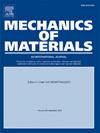等效包含法(EIM)的各向同性和各向异性空间取向的球面不均匀性:一个统一的计算模块,通过与有限元(FE)模拟的比较验证
IF 3.4
3区 材料科学
Q2 MATERIALS SCIENCE, MULTIDISCIPLINARY
引用次数: 0
摘要
本文主要介绍了Eshelby(1957, 1959, 1961)提出的求解非均匀椭球体夹杂问题的等效包含法。目标是为空间取向的各向同性和各向异性球体开发一个统一的EIM程序,并以受控和严格的方式验证开发的每个阶段。首先,对于各向同性无限介质中应变场表达式中涉及到的椭圆积分的空间导数的解析计算,对于椭球体尽可能地进行了推演,并像Vincent et al., 2014对Prolate形状所做的那样进行了编码。然后,介绍了球面相对于附着在无限介质上的全局轴系的空间取向。最后处理了各向异性金属不均匀性,并有可能分配不同的晶体取向。在涉及空间方向和各向异性的最后配置中,必须同时管理三个轴系统。这种复杂性使得对这种情况进行渐进评估是合理的。因此,代码中引入的每个新功能都是通过将结果与非均匀性内外的有限元参考解决方案进行比较来仔细验证的。这首先是对各向同性不均匀性进行的,对于各向异性不均匀性也是如此。这些评估提出了不同的形状,纵横比,属性对比。这样一个完整的评估涉及到每个阶段的各种情况,并检查了内部和外部的不均匀性领域,构成了当前工作的原始贡献,并允许对拟议的代码充满信心(可根据要求提供)。本文的另一个贡献是分析了各向异性和球面非均匀性的空间取向相结合时,各种因素(形状、纵横比、空间取向)对场分布的影响。最后一部分还说明了EIM处理这种分析的效率,同时具有准确性和较低的计算成本。本文章由计算机程序翻译,如有差异,请以英文原文为准。
Equivalent Inclusion Method (EIM) for isotropic and anisotropic spatially oriented spheroidal inhomogeneities: A unified calculation module validated via comparisons to Finite Element (FE) simulations
This paper is centered on the Equivalent Inclusion Method due to Eshelby (1957, 1959, 1961) to solve inhomogeneous ellipsoidal inclusion problems. The objective is to develop a unified EIM program for spatially oriented isotropic and anisotropic spheroids and validate each stage of the developments in a controlled and rigorous way. At first, the analytical calculations of spatial derivatives of the elliptic integrals, involved in the expression of the strain field in the isotropic infinite medium, are pushed as far as possible for an Oblate spheroid and coded as it was done by Vincent et al., 2014 for the Prolate shape. Then, spatial orientation of the spheroid with respect to the global axis system attached to the infinite medium is introduced. Anisotropic metal inhomogeneities are finally dealt with, with the possibility to assign different crystallographic orientations. In this final configuration involving both the spatial orientation and anisotropy, three axis systems have to be managed simultaneously. Such a complexity legitimates a progressive evaluation towards this case. Thus, each new functionality introduced in the code is carefully validated by comparisons of the results to Finite Element reference solutions both inside and outside the inhomogeneity along different paths from the interface. This is done for an isotropic inhomogeneity without and with spatial orientation at first, and for an anisotropic inhomogeneity in the same way. These evaluations are presented for different shapes, aspect ratios, property contrasts. Such a complete evaluation involving at each stage various cases and examining the fields inside and outside the inhomogeneity constitutes an original contribution of the present work and allows to be confident in the proposed code (available on request). Another contribution of the paper is to analyze the influence of various factors (shape, aspect ratio, spatial orientation) on the fields distribution when both the anisotropy and the spatial orientation of the spheroidal inhomogeneity are combined. This last part illustrates also the efficiency of the EIM to deal with such an analysis with both accuracy and a low calculation cost.
求助全文
通过发布文献求助,成功后即可免费获取论文全文。
去求助
来源期刊

Mechanics of Materials
工程技术-材料科学:综合
CiteScore
7.60
自引率
5.10%
发文量
243
审稿时长
46 days
期刊介绍:
Mechanics of Materials is a forum for original scientific research on the flow, fracture, and general constitutive behavior of geophysical, geotechnical and technological materials, with balanced coverage of advanced technological and natural materials, with balanced coverage of theoretical, experimental, and field investigations. Of special concern are macroscopic predictions based on microscopic models, identification of microscopic structures from limited overall macroscopic data, experimental and field results that lead to fundamental understanding of the behavior of materials, and coordinated experimental and analytical investigations that culminate in theories with predictive quality.
 求助内容:
求助内容: 应助结果提醒方式:
应助结果提醒方式:


